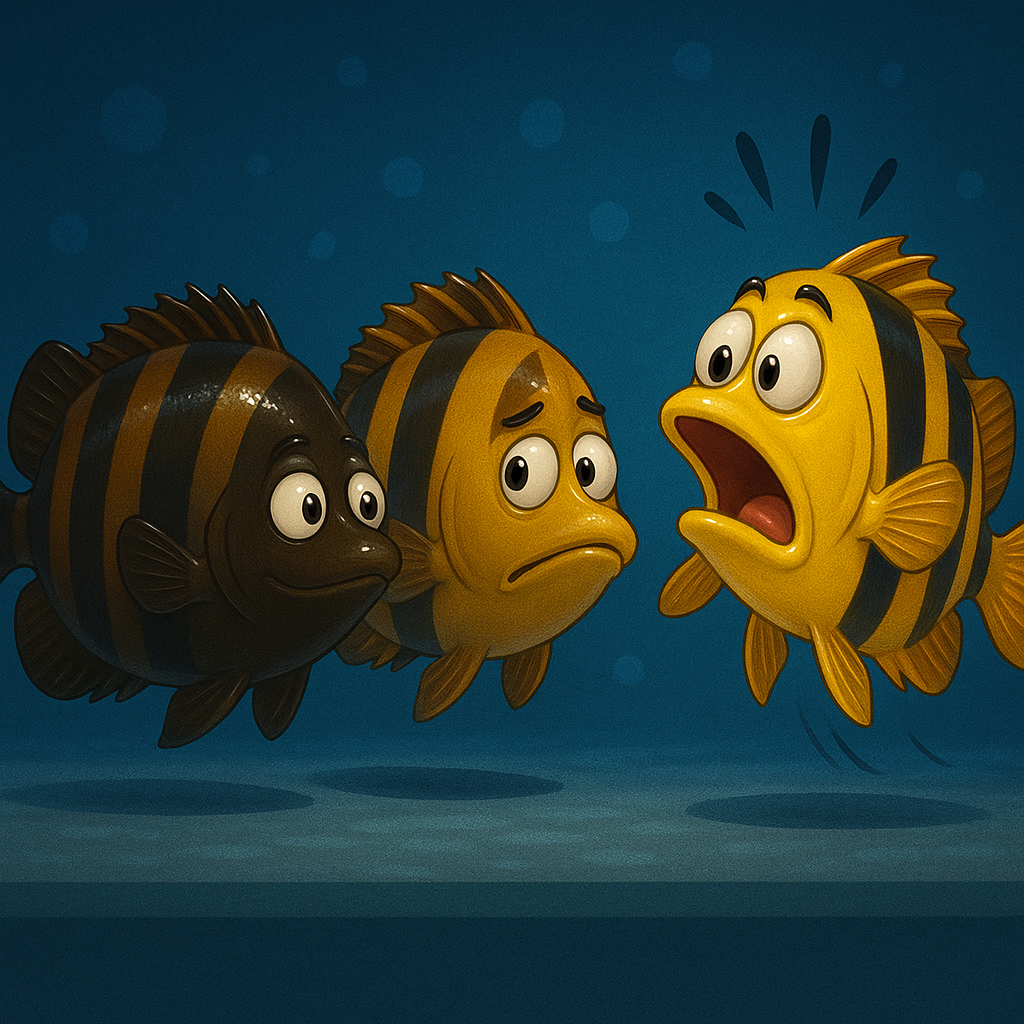🐯 Datnoid Stability — Deep-Dive
✅ What it looks like
- 🌕 Stable: bright base, crisp bars, 👀 confident cruising, 🍽️ eager feeder (bars steady all day).
- 🌗 Semi-stable: color/bars cycle after triggers (💡 lights, 🧰 maintenance), recovers in minutes.
- 🌑 Unstable: dark/grey wash, bars faint/muddy, 🙈 hiding, 🍽️↓ appetite.
🧪 Water & Chemistry Targets
- 🧫 Ammonia/Nitrite: 0 ppm
- 🧯 Nitrate: < 20–30 ppm (🎯 ≤15 ideal)
- ⚖️ pH: 6.8–7.8 (📉 day-to-day swing ≤0.2)
- 🧱 KH/GH: 3–8 dKH / 6–12 dGH
- 🌡️ Temp: 78–82°F (25.5–28°C); 🔁 daily swing ≤1°F (0.5°C)
- 💨 Dissolved O₂: ≥7 mg/L (or ≥90% sat) → run an airstone / strong surface ripple
- 🔌 TDS: 150–350 ppm typical
- 🧂 Optional light brackish (species-dependent): SG 1.002–1.005 (≈3–7 ppt) — only if compatible; 🚫 no yo-yo salinity
⏱️ Sudden blackout? 🧪 Test water first — chemistry slips cause most crashes.
💡 Light, Background & Visuals
- 💡 Intensity: moderate/diffused; avoid harsh spotlights (aim ~300–800 lux mid-water)
- 🕰️ Photoperiod: 8–9 h with 15–30 min ramp ↑/↓
- 🖤 Background: matte dark on back + one side to kill reflections
- 🪨 Substrate: darker sand/fine gravel = less glare → bolder fish
- 🪞 Reflections: cover end panes, reduce room backlighting
🌊 Flow & Oxygen
- 🔁 Turnover: 6–8× tank volume/hr (filter + powerheads)
- 🌬️ Surface break: angle return/wavemaker ~15–20° for constant ripple
- 🧭 Dead zones: small pump behind wood/rock to keep water moving
🪵 Aquascape = Confidence
- 🧱 Sight breaks: at least 3 partitions so fish can “own” zones
- 🌳 Shaded lanes: overhanging wood + floaters = safe retreat paths
- 🛣️ Runway: keep a clear front corridor for cruising (reduces panic bursts)
🐟 Social Setup
- 👤 One datnoid or 👥 5+ in big tanks; 2–4 = bullying → chronic instability
- 🏠 Tank size (rule-of-thumb): solo adult 125–180 gal; groups 180–240+ gal (📏 footprint > height)
- 👯 Dithers: calm, non-nippy mid-water (e.g., silver dollars, larger peaceful barbs)
- 🔍 Species vibe:
- 🇮🇩 Indo (IT): bolder, stabilizes quicker
- 🇵🇬 NGT: skittish; cycles more
- 🇹🇭 ST/AT: confident with space/cover
🍽️ Feeding That Builds Confidence
- ⏲️ Juveniles: 2–3 small meals/day · Adults: 1–2/day
- ⚖️ Amount: ~1–2% body weight/day (adjust to condition)
- 🥩 Menu: quality carnivore pellets, prawn/shrimp, white fish, mussel; rotate
- 💊 Vitamins: soak frozen 1–2×/week
- 🚫 Avoid: feeder fish (disease/behavior issues)
- 🎯 Weaning tip: mix a few pellets into favorite frozen; add 10–15% more pellets each feed until they take dry first
🧠 Stress & Time Course
- ⏱️ Seconds–minutes: startle → melanophores expand → dark wash
- 🕐 Minutes–hours: bars return once calm
- 📆 Weeks: new arrivals may cycle 2–6 weeks before truly settling
🏥 Health Triage (when darkness persists)
- 🚩 Red flags: long blackout + weight loss, stringy feces, flashing, labored breathing
- 🦠 Suspects: gill/skin flukes, internal protozoa, bacterial stress
- 🧭 Steps: stabilize water & O₂ → add cover → observe 48–72 h → if no improvement, treat (e.g., prazi for flukes; metro-based for suspected internal protozoa). 🧪 Quarantine if possible.
🧭 Acclimation Playbook
Day 0–2 (arrival):
- 😎 Dim lights, cover 3 sides, minimize traffic
- 🌡️ Match temp/pH; drip; introduce to pre-dimmed tank
- 🍤 Tiny feed once exploring (don’t chase food)
Day 3–7:
- ⏰ Start 8–9 h photoperiod with ramp
- 👯 Add dither fish (if planned)
- 💧 Hold NO₃ ≤15–20 ppm; 25–35% WC mid-week
Week 2–4:
- 🧱 Uncover one side; keep dark background
- 💡 Increase light gradually; retain shaded zones
- 🍽️ Lock routine; begin pellet weaning if needed
🧰 Rapid Troubleshooter (order matters)
- 🧪 Water check (NH₃/NO₂⁻ 0; NO₃ ≤20–30; temp stable)
- 💨 Boost aeration / surface ripples
- 🖤 Kill reflections; dark background; dim lights
- 🪵 Add sight breaks/cover; check bullying (👤 or 👥5+)
- 🍤 Improve diet routine; add 1 fasting day/week
- 🩺 Still off after 72 h? Investigate parasites/illness
📊 Stability Scorecard (track AM / Noon / PM)
- 🔴 0–3 = Unstable (dark, hidden, won’t eat)
- 🟠 4–6 = Semi-stable (cycles, inconsistent eating)
- 🟢 7–10 = Stable (bright bars all day, eager eater)
🔑 Takeaway
Nail water, oxygen, visual comfort, social structure, and routine. With those locked, most datnoids migrate unstable → semi-stable → stable, only dipping briefly after predictable triggers (💡 lights, 🧰 maintenance, 🥊 dominance sparring).
